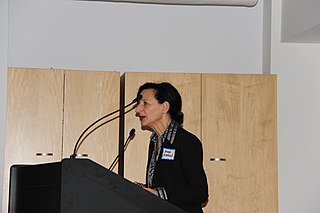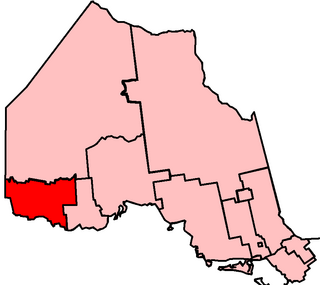Related Research Articles

Ronald James Deibert is a Canadian professor of political science, philosopher, founder and director of the Citizen Lab at the Munk School of Global Affairs, University of Toronto.
Gail Sheryl Asper is a Canadian heiress, philanthropist, and corporate lawyer. Daughter of the media magnate Izzy Asper, she serves as the president and a trustee of the Asper Foundation.
Canadian royal symbols are the visual and auditory identifiers of the Canadian monarchy, including the viceroys, in the country's federal and provincial jurisdictions. These may specifically distinguish organizations that derive their authority from the Crown, establishments with royal associations, or merely be ways of expressing loyal or patriotic sentiment.
Dilbit is a bitumen diluted with one or more lighter petroleum products, typically natural-gas condensates such as naphtha. Diluting bitumen makes it much easier to transport, for example in pipelines. Per the Alberta Oil Sands Bitumen Valuation Methodology, "Dilbit Blends" means "Blends made from heavy crudes and/or bitumens and a diluent, usually natural-gas condensate, for the purpose of meeting pipeline viscosity and density specifications, where the density of the diluent included in the blend is less than 800 kg/m3." If the diluent density is greater than or equal to 800 kg/m3, the diluent is typically synthetic crude and accordingly the blend is called synbit.
In Canada, a number of sites and structures are named for royal individuals, whether a member of the past French royal family, British royal family, or present Canadian royal family thus reflecting the country's status as a constitutional monarchy under the Canadian Crown. Those who married into the royal family are indicated by an asterisk (*). Charles Edward Stuart was a pretender to the British throne.

The Diamond Jubilee of Queen Victoria was officially celebrated on 22 June 1897 to mark the occasion of the 60th anniversary of Queen Victoria's accession on 20 June 1837. Queen Victoria was the first British monarch ever to celebrate a Diamond Jubilee.
David William Schindler,, was an American/Canadian limnologist. He held the Killam Memorial Chair and was Professor of Ecology in the Department of Biological Sciences at the University of Alberta in Edmonton, Alberta. He was notable for "innovative large-scale experiments" on whole lakes at the Experimental Lakes Area (ELA) which proved that "phosphorus controls the eutrophication in temperate lakes leading to the banning of phosphates in detergents. He was also known for his research on acid rain. In 1989, Schindler moved from the ELA to continue his research at the University of Alberta in Edmonton, with studies into fresh water shortages and the effects of climate disruption on Canada's alpine and northern boreal ecosystems. Schindler's research had earned him numerous national and international awards, including the Gerhard Herzberg Gold Medal, the First Stockholm Water Prize (1991) the Volvo Environment Prize (1998), and the Tyler Prize for Environmental Achievement (2006).

The year 2012 marked the Diamond Jubilee of Elizabeth II being the 60th anniversary of the accession of Queen Elizabeth II on 6 February 1952. The only diamond jubilee celebration for any of Elizabeth's predecessors was in 1897, for Queen Victoria.

Sara Louise Diamond, is a Canadian artist and was the president of OCAD University, Canada.
IISD Experimental Lakes Area is an internationally unique research station encompassing 58 formerly pristine freshwater lakes in Kenora District Ontario, Canada. In response to the International Joint Commission (IJC)'s 1965 recommendations related to transboundary pollution, the federal and provincial governments set aside these lakes to study water pollution. During the 1970s and 1980s, David Schindler, who was at that time 'Canada's leading ecologist', conducted a series of innovative, landmark large-scale experiments in ELA on eutrophication that led to the banning of phosphates in detergents. In an unexpected and controversial move that was widely condemned by the scientific community in 2012 the ELA was de-funded by the Canadian Federal Government. The facility is now managed and operated by the International Institute for Sustainable Development (IISD) and has a mandate to investigate the aquatic effects of a wide variety of stresses on lakes and their catchments. IISD-ELA used the whole ecosystem approach and makes long-term, whole-lake investigations of freshwater focusing on eutrophication.

Tony Van Bynen is a Canadian politician, who was elected to the Canadian House of Commons in the 2019 Canadian federal election. He represents the district of Newmarket—Aurora as a member of the Liberal Party of Canada, and previously served as mayor of Newmarket, Ontario from 2006 to 2018.
Alan Bernstein is Professor Emeritus at the University of Toronto and President Emeritus of CIFAR, where he served as President and CEO from 2012 to 2022. A Distinguished Fellow at the Munk School of Global Affairs and Public Policy, he is also a Fellow and Member of the Standing Committee for Science Planning at the International Science Council (2022-2025). Bernstein is recognized as a leader in health research, science policy, mentorship and organizational leadership.

The Queen Elizabeth II Diamond Jubilee Medal or The Queen's Diamond Jubilee Medal was a commemorative medal created in 2012 to mark the 60th anniversary of Queen Elizabeth II's accession in 1952. There are four versions of the medal: one issued by the United Kingdom, another by Canada, the third for the Caribbean realms of Antigua and Barbuda, the Bahamas, Barbados, Grenada, Jamaica, Saint Kitts and Nevis, Saint Lucia, and Saint Vincent and the Grenadines, and the fourth issued by Papua New Guinea. The ribbons used with the Canadian and British versions of the medal are the same, while the ribbon of the Caribbean and the Papua New Guinean medal differ slightly. The different iterations of the medal were presented to tens of thousands of recipients throughout the Commonwealth realms in the jubilee year.
The Royal Collection Project is a body of seventy five contemporary Canadian watercolours housed within The Royal Collection of Queen Elizabeth II.

The International Institute for Sustainable Development (IISD) is an independent think tank founded in 1990 working to shape and inform international policy on sustainable development governance. The institute has three offices in Canada - Winnipeg, Ottawa, and Toronto, and one office in Geneva, Switzerland. It has over 150 staff and associates working in over 30 countries.
Ludwig "Lu" Norbert Carbyn is an internationally recognized expert on wolf biology, a research scientist emeritus at the Canadian Wildlife Service, and an adjunct professor at the University of Alberta in Edmonton, Alberta. He has studied wolf ecology and behaviour in Canada since 1970, including pioneering research into the ecological role of wolves as predators in the Canadian Rocky Mountains and great plains as well as the wolf-bison ecosystem of Wood Buffalo National Park. On a Canadian Wildlife Service assignment in Jasper National Park, he became the first human to study wild wolves from within a wolf pack using habituation, a method of gaining insights into the biology of wolves portrayed in fiction by Farley Mowat's popular book and film, Never Cry Wolf.

Karen Ann Kidd is a Canadian aquatic ecotoxicologist. She is the Jarislowsky Chair in Environment and Health and Professor of Biology at McMaster University and member of the International Joint Commission.
Lake 226 is one lake in Canada's Experimental Lakes Area (ELA) in Ontario. The ELA is a freshwater and fisheries research facility that operated these experiments alongside Fisheries and Oceans Canada and Environment Canada. In 1968 this area in northwest Ontario was set aside for limnological research, aiming to study the watershed of the 58 small lakes in this area. The ELA projects began as a response to the claim that carbon was the limiting agent causing eutrophication of lakes rather than phosphorus, and that monitoring phosphorus in the water would be a waste of money. This claim was made by soap and detergent companies, as these products do not biodegrade and can cause buildup of phosphates in water supplies that lead to eutrophication. The theory that carbon was the limiting agent was quickly debunked by the ELA Lake 227 experiment that began in 1969, which found that carbon could be drawn from the atmosphere to remain proportional to the input of phosphorus in the water. Experimental Lake 226 was then created to test phosphorus' impact on eutrophication by itself.

References
- ↑ "Diane Orihel". Queen's Experimental Ecology & Ecotoxicology. 2018-03-12. Retrieved 2020-01-16.
- 1 2 "Diane Orihel". Canadian Geographic. 2019-06-17. Archived from the original on 2020-02-29. Retrieved 2020-02-29.
- 1 2 3 4 Hoag, Hannah (2013-10-31). "Ecology: Lady of the lakes". Nature News. 502 (7473): 612–613. Bibcode:2013Natur.502..612H. doi: 10.1038/502612a . PMID 24172962.
- 1 2 Riordon, Michael (2014). Bold Scientists: Dispatches from the Battle for Honest Science. Toronto: Between the Lines. ISBN 978-1771131247.
- ↑ Barlow, Maude (2016). Boiling Point: Government Neglect, Corporate Abuse, and Canada's Water Crisis. Toronto: ECW Press. ISBN 9781770413559.
- ↑ McDiarmid, Margo (May 17, 2012). ""Budget cuts claim famed freshwater research facility"". CBC Canada. Retrieved 2020-01-16.
- ↑ "Global Research Possibilities Expand as IISD Assumes Operation of Canada's Renowned Experimental Lakes Area". 2014-04-09. Archived from the original on 2014-04-09. Retrieved 2020-01-16.
- ↑ Thompson, Jon (December 19, 2012). ""Orihel receives Queen Elizabeth II Diamond Jubilee Medal for her ELA efforts"". Winnipeg Sun. Retrieved 2020-01-16.